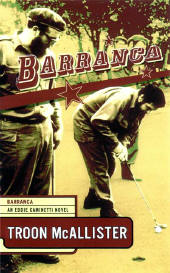Barranca
Imagine two national security scenarios.
In the first one, a former national security advisor visits the National Archives to review classified documents relating to terrorism and the work done by the Administration in which he served. Archive staffers witness the senior government official place secret documents inside his clothing, and then leave the building.
In the second one, a national crisis develops that involves a major South American commodity on which the U.S. economy critically depends. The President recruits a golf hustler who’s previously beaten him and other high government officials to travel south to meet the revolutionary who’s causing all the trouble. That’s because the leader of the uprising happens to be a golf addict. The White House hopes to restore the nation’s economic health with a golf match between the hustler and the revolutionary.
Troon McAllister’s Barranca is the basis for the second scenario. Unfortunately, the first scenario is based on very recent facts.
The juxtaposition of these two circumstances proves once again that a satirist’s work always runs the risk of being overtaken by actual events even more bizarre than the writer could invent.
Thankfully, we can laugh about the second one, because McAllister shows no signs of coasting on the talents he displayed in The Green, The Foursome, and Scratch. This new book is every bit the equal of the first three in the Eddie Caminetti series, and if possible the satire is even more biting.
The basic plot for Barranca was inspired by a odd little bit of history for which documentary proof actually exists. Alberto Korda shot pictures of Che Guevara and Fidel Castro playing golf, and in at least one picture there are a few others in the group.
McAllister’s own bold stroke was to come up with a thoroughly believable background story about one of the witnesses to the Che/Castro match. Suppose Manuel Villa Lobos de Barranca was Castro’s caddie. Suppose that decades later he’s managed to apply revolutionary principles from Che and Castro, but without the mistakes and bloodshed that marked the efforts of those two socialists.
Just suppose that Barranca has also quietly found a way to corner the market for coffee, whose resulting shortages cause havoc among millions of caffeine addicts in the United States. The usual diplomatic measures are ineffective, and President Eastwood is desperate to find a way out of the mess.
Naturally, golf is the path to national salvation, which means that Eddie Caminetti must be brought in to save the day. After all, the essence of great fiction is the ability to induce the willing suspension of disbelief in its readers.
In the little world that McAllister created, using Caminetti to make a deal with Barranca makes perfect sense. And as we know from past experience, any deal with Caminetti is bound to have a few twists in it, with Caminetti usually at a distinct advantage over his competition.
The story structure McAllister uses for this latest edition is a bit jarring at first, because it’s not linear. By putting the end of the story in the middle and the middle of the story at the end, McAllister often induces the reader to make intuitive leaps that don’t pan out. This device plays on the reader’s assumptions in much the same way that Caminetti succeeds in his various scams.
Eddie doesn’t have to use any real trickery to make his money, because his marks trick themselves instead. In this case, however, Caminetti may have just met his match. Barranca shows Caminetti that he also knows how to use this technique, and that’s when things become really interesting.
In the meantime, McAllister has a lot of fun. There’s a scene at a Starbucks Coffee shop that will make some readers spew their Grandés. Based on my own experience, the interplay between government officials and the media is extremely lifelike and brutally funny.
In one major plotline, a remarkably dense anchorwoman for a CNN-like cable news outfit sees the crisis as a chance for a major scoop. She won’t let her own lack of talent impede her efforts to make this story all her own.
In fact, the media’s critical role in the novel reminded me very much of the movie Wag the Dog—and as one recent convict says, “That’s a good thing.”
This was a delightfully funny satire. I just hope that McAllister’s next book isn’t overtaken by reality. This one came close.
Review Date: July 23, 2004


